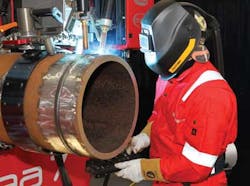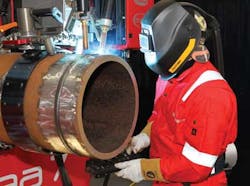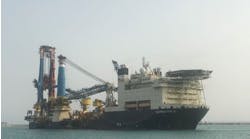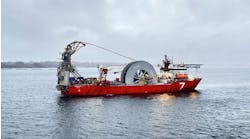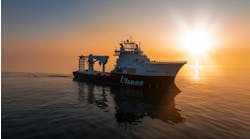Jeremy Beckman
Editor, Europe
Earlier this year, Subsea 7 opened its new Global Pipeline Welding Center in Scotland. The £10-million ($15.9-million) base is designed partly to further research and development (R&D) into new welding techniques for laying and protecting pipes in harsher offshore environments. It will also test processes to improve accuracy and productivity of welding of high-strength steel and corrosion-resistant alloy pipes on the company's pipelay vessels and at its various onshore spool bases.
Subsea 7's new welding center is designed to test and qualify new welding procedures and technologies.
The center is managed by the company's Pipeline Production Group (PPG) and employs more than 150 engineers, welders, technicians, and support personnel. PPG qualifies Subsea 7's welding procedures, and its responsibilities include quality control throughout the group's facilities, managing production at the firing line, providing welding services for offshore pipeline tie-ins, and supervising subcontractors brought in for field joint coating operations.
Since 2010, Subsea 7 has worked with CRC-Evans Pipeline International to develop automatic welding technologies to replace traditional manual and semi-automatic processes. The new complex will provide much larger capacity for the various programs, and will continue to adapt the CRC-Evans "bug-and-band" systems and other equipment for use in J-lay, S-lay, reel-lay, and installation of rigid pipeline bundles produced at the Wester site in northern Scotland. Subsea 7 is the sole subsea contractor providing pipelay by all four methods, and each imposes distinct welding demands.
The 22,100-sq m (237,882-sq ft) site for the new complex is west of Glasgow on the River Clyde. It comprises two main buildings, Pipeline Development Center 1 (PDC1) and PDC2. PDC1's 12,400-sq ft (1,152-sq m) workshop includes what is claimed to be a unique simulated welding production line, designed to perform realistic trials of, and to qualify, automatic welding technologies prior to deployment at Subsea 7 pipe fabrication bases in Angola, Brazil, Norway, the UK, and US. Here two 40-ft (12-m) pipeline strings can be rotated, aligned, and welded under controlled conditions. The production line is also used to train pipeline welders in automated techniques, training of inspectors, and for client demonstrations.
The workshop area has 500-lux lab status lighting. A 500-kVA substation provides electric power, while external tanks in a dedicated gas room feed compressed welding gases through five lines to each welding bay. Steel swarf generated by beveling is removed for recycling automatically via an under-floor conveyor system.
Fourteen welding and inspection bays are equipped with computer-controlled "band-and-bug" automatic welding systems, some of which incorporate dual welding heads and are motorized for pipe rotation. These bays also provide workstations to perform non-destructive testing (NDT) weld inspection procedures. Three other bays are dedicated to pipe beveling, while Subsea 7 plans to add a tower/turntable facility to recreate welding conditions on vertically laid (J-lay) 10-m (33-ft) pipe lengths, made possible by a 16-m (52.5-ft) high roof.
Pipes are transferred from pipe storage racks outside the center by a forklift vehicle with three swiveling wheels, allowing single-direction delivery. Inside the center, two overhead 5-metric ton (5.5-ton) cranes transport pipe stalks and are synchronized for tandem lifts, if needed. Pipes up to 22-in. diameter can be cut to size using a computer-controlled automatic band saw.
PDC2 houses the center's R&D facilities, with storage areas segregated for carbon steel and corrosion-resistant alloy pipes to avoid cross-contamination. Facilities include 24 workstations, NDT offices with a dark room and viewing room, and a metallurgical laboratory for preparation of samples. There is also a workshop containing three more automatic welding/inspection bays, two manual welding bays, and a 14-m (46-ft) sealed radiography bunker for NDT testing of pipe lengths up to 12 m (39 ft) for reeling and fatigue testing. Two NDT bays are used for automatic and manual ultrasonic testing.
One of Subsea 7's most recent developments is the Aquasol By-Pass Purge system for offshore pipe tie-in welds, first deployed from theSeven Oceans vessel during pipelay for Statoil's Skuld field offshore Norway. One difficulty often encountered in tie-in operations is the "suck and blow" conditions within the pipeline. This can obstruct creation of the inert purge atmosphere needed to ensure soundness of the girth weld.
The By-Pass Purge deals with this issue via a fully-sealed enclosure that maintains the integrity of the purge gas, and a central vent that allows draughts to pass through the pipeline without disturbing the internal purge gas. The result is improved reliability of offshore welding operations and a decreased risk of extended vessel time.
Another innovation was the deployment last year of Pulsed Gas Metal Arc Welding (PGMAW) technology for fabrication of metallurgically clad pipe at the company's reeled pipeline production plant in Vigra, Norway. This involves use of Controlled Metal Transfer, a Gas Metal Arc Welding technique that enables precise deposition of the root weld, strengthening control of the root-based quality and profile, both important for maintaining the pipeline's corrosion performance. Internal inspection with camera and laser equipment provides assurance of root weld quality.
During the 2012 fabrication campaign at Vigra for Statoil's Skuld, Sterjne, Tordis, and Visund Sor projects, which employed the PGMAW technique, more than 60 km (37 mi) of pipeline were fabricated, made from Grade 415 (X60) steel with 3-mm 316L lining, and in-pipe dimensions ranging from 10- to 16-in. OD. The laser/camera inspection reject rate was below 1.4%, while the Automated Ultrasonic Testing rejection rate on final inspection procedures was maintained at a low level of typically 0.2%.
Future goals, according to the center's technical manager Eric Law, include developing welding procedures for higher-strength steels, possibly up to X80 grade; and developing internal and external welding technologies in anticipation of future market needs.
According to Subsea 7, field development in increasingly deepwaters has three main consequences on pipeline specifications and the associated welding needs. First, operators are drilling production wells with higher operating pressures and temperatures, and are seeking to enhance pipeline life beyond 25 years. These issues are addressed by increasing pipeline wall thicknesses and using higher-strength carbon steels.
Secondly, the trend toward transportation of corrosive fluids calls for higher levels of pipeline protection. This can be achieved through use of corrosion-resistant alloy (CRA) pipe or by protecting the carbon steel pipe with a CRA cladding or liner (applied via a metallurgically-clad or mechanically-lined process or through swaging with a plastic liner).
The third issue in deepwater projects is maintaining the correct product temperature within pipelines to avoid wax or hydrate formation. The three main approaches involve either applying a wet insulation coating to the pipeline; a pipe-in-pipe (PIP) solution in which the production line is sleeved into an outer pipeline and the annulus filled with an insulation material; or combining PIP with low-power electrical trace heating, particularly suited to longer shutdown and start-up conditions and longer tieback distances. Subsea 7 has collaborated with ITP Interpipe to develop electrically-trace heated PIP, which can be installed via reel-lay, and which allows use of a smaller outer pipe than passively insulated systems.
